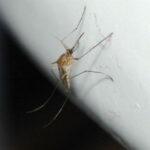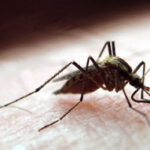It’s taken us a while to catch on to malaria. We still call it “bad air”, as in “the bad night air made him sick”, but we feel a little less dumb because we do so in French (mal aria). And the disease is caused by something that comes in through the window: mosquitoes.
If you live in a developed country, your chances of infection are about zero. Public sanitation projects and spraying reduce the number of mosquitoes. Your house is probably close to air-tight, with glass and screens in the windows and air-conditioning to make any insect intruders feel unwelcome. It may be too cold for the Anopheles mosquito, the primary vector, to winter where you are anyway. And finally, it takes a critical mass of human malaria vectors in your area for the disease to establish itself: the mosquito has to sip from an infected person, and later from your blood to transmit the disease to you.
But the developing world generally has everything malaria is looking for: warm weather, easily infiltrated housing, and a lack of resources for insecticides, medication, and infrastructure changes that discourage mosquitoes and/or malaria. There are around 515 million cases of malaria, resulting in between one and three million deaths. A mosquito net is one of the cheapest ways of protecting individuals from malaria and reducing its prevalence in entire communities.
The nets themselves are cheap — two to ten dollars — and in countries where you keep something until it falls apart, they can be mended with needle and thread almost indefinitely. They are effective by themselves, but are even more so if they are soaked a few times a year in an insect repellent, which might cost a quarter a packet. One complication is that the soaking should be done in a container that is not used for other purposes — especially not for food — and one should wear gloves when soaking the net (some brands of dip come with a single-use pair of gloves, like a home hair-dying kit.) These sound like minor expenses, but the lifetime cost of owning and treating a net can be considerable, especially for a family that grows its own food and only occasionally obtains hard currency — a primary target of malaria eradication effort.
Philanthropic investors often face a cat-came-back syndrome: as much as they try to donate to causes in the developing world (where many feel the need is most dire and a dollar stretches the furthest), they can frequently watch their donation trickle back into the developing world, frequently into the hands of those who hold the most money. Salaries for American employees working in the U.S. or abroad, American advertising firms and infrastructure costs, etc. Even when the money is spent in the developing world, it frequently comes right back to the developed as purchases of pharmaceuticals, manufactured goods, and other exports. Money earmarked for the purchase of a mosquito net (and/or community-based workshops that demonstrate its use and other health issues) has an immediate benefit in the intended community, and as these nets are increasingly manufactured in the developing world, your purchase supports salaries, corporate earnings, and an incentive for investment where all three are badly needed.
If you’re taken a personal interest in where your charitable contributions go, either by donating directly through grass-roots charities or by taking an active role in the charities that are the recipients of your donations, then you may view mosquito nets as a wise investment with a lifetime of dividends.




